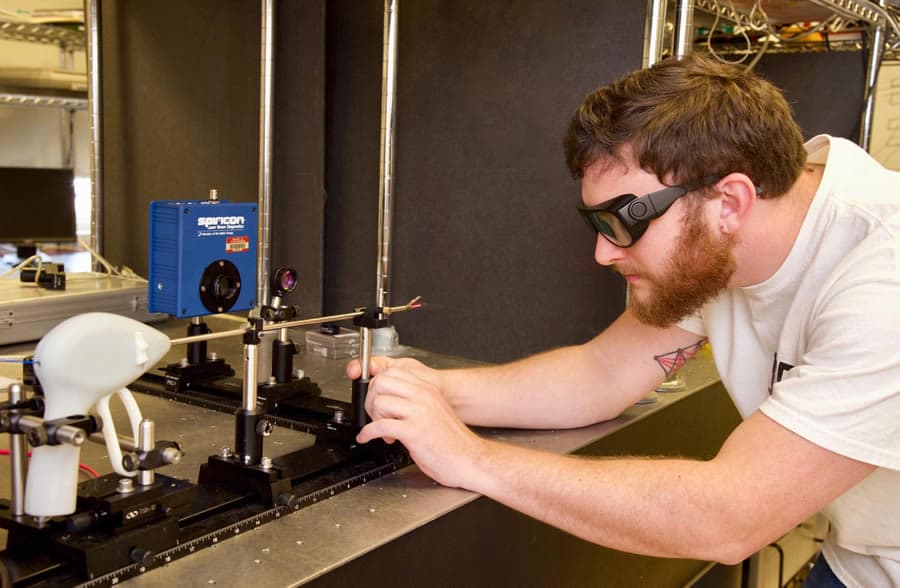
Most North Carolinians have known someone who has had kidney or bladder stones. The pain can be excruciating – a stabbing sensation in the side, abdomen or back. It can start in one spot in the intestinal tract, then spread. The agony can bring people to tears – and, often, to the hospital emergency room.
UNC Charlotte student Luke Hardy, who is pursuing a doctoral degree in optical science and engineering, is a member of a research team working to transform treatment options.
“We’re in what is called the Stone Belt. The Southeastern part of the United States, including North Carolina, South Carolina and Virginia, has more kidney stone occurrences than other places, about a 50 percent greater prevalence of stone disease,” said Hardy.
Stone incidence and the costs, increase
With the incidence of stones increasing not only in the Southeast but elsewhere too, due to rising obesity, diabetes, dietary factors and even climate change, Nathaniel Fried’s research lab in the Department of Physics and Optical Science is working to transform treatment options. Hardy is an integral member of the research team.
“Luke is a highly accelerated student by all measures,” Fried said. “One of his greatest strengths is that he works extremely hard. He’s very focused and a very serious student. It’s his curiosity, his heart, his work ethic and his productivity. He’s just done so much. He’s really a role model for other students.”
Hardy first joined Fried’s lab as an undergraduate physics student participating in the Charlotte Research Scholars program in summer 2013. Since then, he has been a co-author on more than a dozen peer-reviewed papers and a similar number of conference proceedings. He also received a 2017 Optics and Photonics Education Scholarship from SPIE, the International Society for Optics and Photonics.
“I like learning things and figuring things out, and I’ve always wanted to use that interest in helping people in some way,” Hardy said. “I felt like this work was a good way to do that.”
The specific area of research is called biomedical optics and laser-tissue interactions, mostly occurring in the therapeutic realm.
“You can think about it as minimally invasive surgery using lasers, optics and/or fiber optics,” Fried said. “We do a little bit of optical imaging and what I would call diagnostics, diagnosing disease or characterizing abnormalities. But most of the work is on the therapy side for treatment.”
The research is exploring less invasive surgical options, seeking to speed recovery time, decrease complications and time spent in surgery, and reduce costs for patients and the health care system. That is where the innovative devices that Fried’s lab develops come in.
“There has been little or no evolution in laser technology for treating kidney stones in the last 30 years or so,” Fried stated. “We are one of only a few academic labs that I know of in the world that is trying to introduce new laser technology for breaking up kidney stones. The conventional technology has been around for almost 30 years. The technology that Luke is working on in the lab as part of his project allows us to miniaturize the optical fiber delivery system, and perhaps the endoscope as well, that goes inside the body.”
Hardy counts his work with the Thulium fiber laser for breaking up kidney stones as some of his most productive.
“One of the major issues with the laser we are researching now is that it operates at very low pulse energy,” he said. “We were limited by that. We were able to show that what you need to do is pulse it faster, to increase the average power. You can ablate the kidney stones faster, and there’s also a reduction in the movement of the stone compared to the current lasers in use. Then, later on, we were able to show by using a fast camera why there was a reduction in the movement of the stone. There are a lot of reasons why reducing the movement of the stone is important.”
The pinball phenomenon
When a stone breaks up, it can bounce around, much like a pinball in a pinball machine. Pieces can be missed, requiring more surgery, or the patient has to let the fragment pass while the urinary tract is still healing. If a stone moves around during the procedure, the surgery also can take longer, which is costly and potentially more risky for the patient.
While much of his work has focused on the actual lasers and probes, Hardy has branched into computer simulations. With this work, the team is researching treatment options that use non-invasive lasers and their thermal effect to remodel subsurface tissues to treat female stress urinary incontinence. Currently, women either learn to live with the condition or turn to more extensive surgical options, such as mesh slings. One of the major themes in the lab’s research is developing options for the use of lasers in urology, with implications for quality of life issues.
“We currently have an NIH grant to look at female incontinence, which is a big problem,” Fried stated. “Millions of women suffer from female incontinence after childbirth and in aging.”